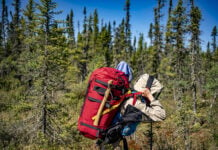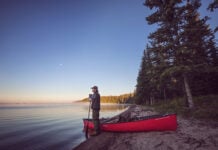Pardon me in advance for yelling.
On morning radio the other day, a 20-something municipal recreation administrator was interviewed about a new protocol to make flooding the neighborhood skating rinks safer. In his city, self-organized and well-intentioned volunteers had done what they needed to do for years, working early in the morning and late into cold nights to make 18 local rinks for their children and grandchildren to stretch their legs on winter days.
Sinking Outdoor Ed
“Is there reason to think flooding rinks is a dangerous activity?” asked the interviewer.
“No,” said the rec administrator, “I don’t know of any examples of people getting hurt making these rinks. We just want them to be safe. So, we’ve created a course for the volunteers to take so they will be able to continue making this contribution to the community without any incidents.”
With no reason to rinky-tinker with a system that has been working fine for decades, but with growing unease about the city’s liability exposure, this municipality decreed anyone involved in the rink-making would need to take a course.
“How is your training program going?” the interviewer followed up. The answer? Many volunteers declined the training and stopped offering their services. The result? Fewer neighborhood rinks were made.

This same over-cautiousness isn’t just affecting community volunteers—it’s threatening the future of outdoor education for school kids. This depressing radio interview coincided with hearing from a former student of mine who said the award-winning secondary school outdoor program she’d been running for the last 25 years—a program that had transformed the lives of thousands of students through ambitious activities, like community volunteering, hiking, canoeing and winter camping, all with a flawless safety record—was on the cusp of being closed.
She’d learned to live with the school board-mandated two-night maximum rule for excursions and with the imposed funding limitations. But now, despite a total paucity of data or evidence that these activities are dangerous, an ever-increasing number of administrators are no longer comfortable supporting such offerings.
Son of a perch!
In today’s risk-averse culture, well-intentioned efforts to ensure safety are dismantling valuable community traditions and educational experiences.
“We need to stand up for paddling and its minimal yet inherent risks,” wrote outdoor educator Bob Henderson in this magazine back in 2018 in an article titled: How Risk Management is Sucking the Life From Kids’ Paddling Trips (paddlingmag.com/0182). “If meeting safety standards is the sole mark of success for a paddling trip [then] the bar is set very low. Should safety be a given? Yes. All trips must be safe. Safety first, but not safety only.”
Studies consistently show getting outside boosts kids’ test scores, reduces stress, and improves behavior and fitness.
I’m sorry to say, Bob, it’s only gotten worse.
While the frequency and length of outdoor excursions steadily shortened over the last three decades, the research on the benefits of outdoor and experiential education as part of any school curriculum has only grown. Studies consistently show getting outside boosts kids’ test scores, reduces stress, and improves behavior and fitness.
Lawyers may caution against risk, but in outdoor education, well-managed challenges lead to almost certain positive outcomes. The gains in capacity, courage, humility, resilience, and confidence that come with chafing against the vagaries of weather, being away from home, and enduring the pain of physical and mental exertion in the woods somehow get eclipsed by the pronouncements of risk-averse administrators with little firsthand experience.
There’s a real conundrum in shutting down outdoor education programs by people who ignore the fact that roads, inactivity, food toxins, gymnasiums, and many team sports—just to name a few—have injury and death rates higher than the actuarial data about the risks of paddling and other demonstrably nourishing outdoor activities.
Excising risk from our children’s lives is not the answer to keeping them safe. More importantly, purposeful inclusion of risk in education sets the stage for meaningful conversations about what those risks might be and how they can be managed to ensure safety.
As any elite climber, pilot, or seasoned outdoor educator will tell you, a key part of the risk equation is acknowledging it fully as part of preparation. Maybe we, as canoeing instructors and wilderness guides, haven’t said enough about this over the years.
Purposefully engaging with the myriad of ways one could get hurt or die shapes what we do, encourages prudent behavior, and sets the stage for dealing with unexpected risks in other contexts. Care is taken. Reward is there for the risk.
The danger isn’t in paddling—it’s bubble-wrapping a generation so tightly they’re too afraid to get their feet wet.
James Raffan is an author, explorer, occasional Zodiac driver, and the former executive director of the Canadian Canoe Museum. Tumblehome appears in every issue of Paddling Magazine.
Bubble wrap not required. | Feature photo: Mike Last



 This article was published in Issue 73 of Paddling Magazine.
This article was published in Issue 73 of Paddling Magazine. 




